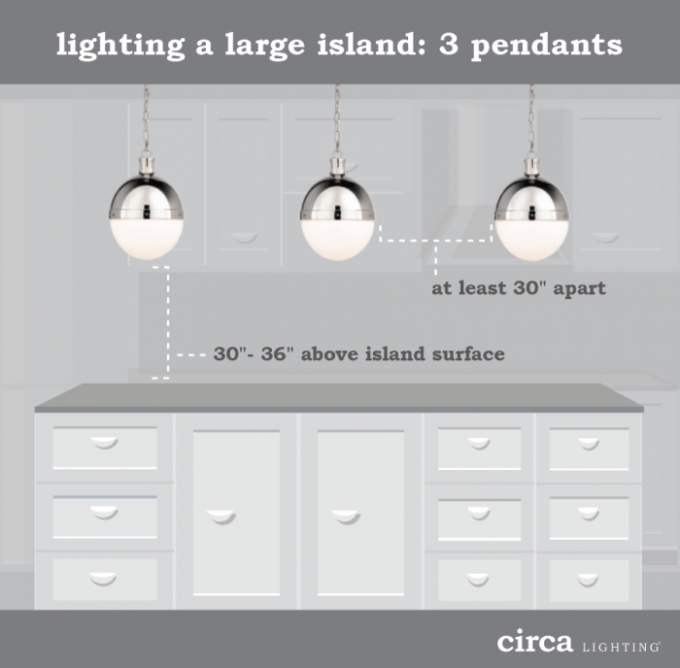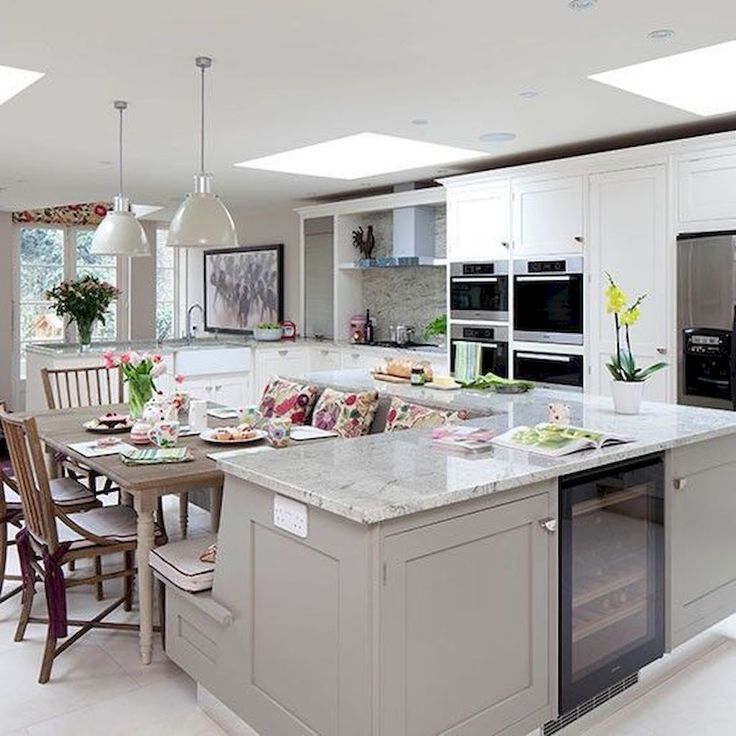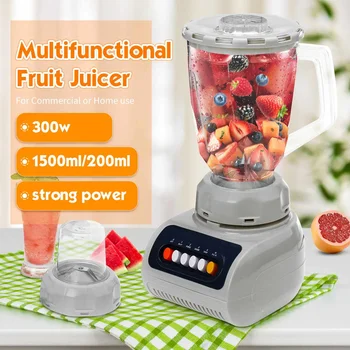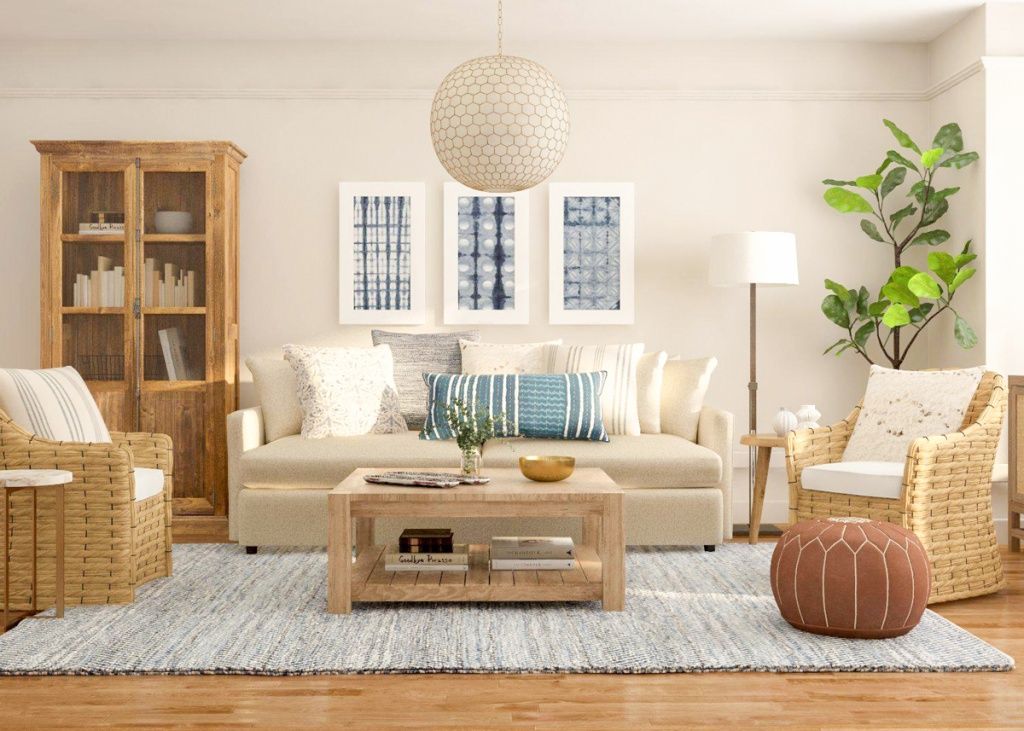How to choose kitchen lighting
How to choose kitchen lighting: with advice from experts
Knowing how to choose kitchen lighting is an important step in the room’s design. Without good lighting for preparation and cooking, as well as for the dining and everyday living that takes place in the room, the space will fall short.
Of course, kitchen lighting ideas should contribute aesthetically as well as playing their part practically. As with elements such as cabinetry, counters, wall decor, and flooring, lighting materials, finishes, and colors as well as shape and style are all crucial to the room’s look.
Here, we examine how to choose kitchen lighting successfully with advice from the experts.
How to choose kitchen lighting
The room’s illumination is critical for a successful kitchen design, so choosing kitchen lighting should never be left to the last minute – it should be amongst your priority list of kitchen ideas. You may want to double-check how much light your kitchen needs before you start thinking aesthetics – a lighting engineer can help with this.
‘The most effective lighting solution is to specify a lighting scheme that allows bright task lighting over the countertops where the food preparation is taking place, and warm, low lighting for the guests,’ says Tom Howley , design director at the eponymous kitchen company.
‘There may only be a 10 feet between these two very different light sources, but it makes the world of difference to your guests’ entertaining experience and the chef or the host’s cooking experience. Strategic lighting will encourage guests to relax and enjoy the kitchen and the informal dining experience.’
Planning kitchen lighting that fulfils these roles will consist of task, ambient, and accent (also known as feature) lighting.
Plan task lighting
(Image credit: Ray Main )
Areas of the kitchen such as counters, the range, cooktop, and sink need to be especially well lit for safe and easy preparation, cooking, and other tasks. Consider the task lighting – such as kitchen wall lighting ideas – which will illuminate these areas early in the process of choosing kitchen lighting.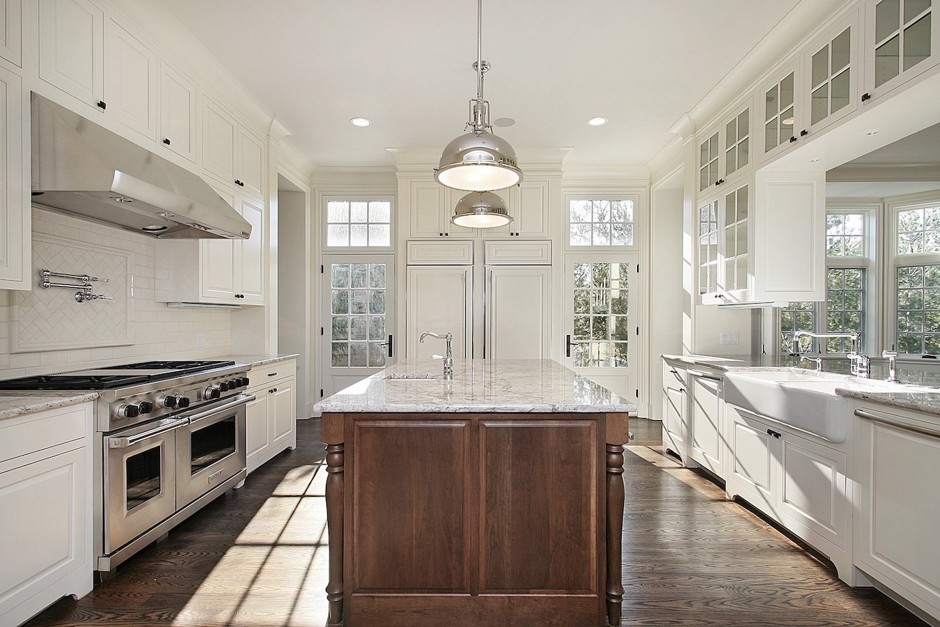
‘Lighting schemes are an essential part of kitchen planning as there is nothing worse than a dimly lit work area,’ says Melissa Klink, head of design at Harvey Jones . ‘Position spots directly above key areas to ensure the light isn’t blocked while you stand at the sink, hob or counter. Utilize under-cabinet lighting to illuminate counters and a lit hood can provide lighting for your cooking area.’
What’s crucial is avoiding shadows. ‘Try to reduce shadows on task areas so when leaning over the counter the lights should not be directly behind you,’ says Piero De Marchis, director, Detail Lighting . ‘Linear LED lighting is good for reducing shadows, above cabinets, under cabinets or linear trimless strips in the ceiling.’
Wall lights could be used where there aren’t wall cabinets, while ceiling lights can provide task lighting, but they must focus light on the work area.
Kitchen island lighting ideas, such as pendant lights, may need to function as task lighting during food preparation, but as ambient lighting for that area once the cooking is over.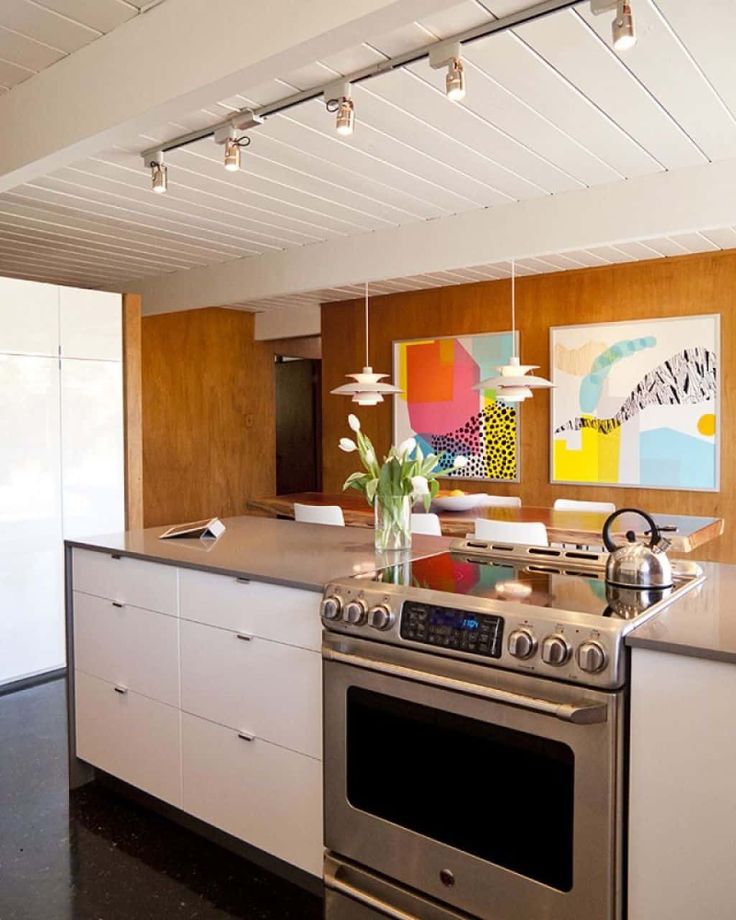 ‘We often recommend incorporating pendant lights that are easily dimmable,’ says David Amos, CEO at Amos Lighting + Home . ‘This is so that you can reduce the brightness down when you have finished your food preparation and then have a relaxed environment to socialize with guests and family.’
‘We often recommend incorporating pendant lights that are easily dimmable,’ says David Amos, CEO at Amos Lighting + Home . ‘This is so that you can reduce the brightness down when you have finished your food preparation and then have a relaxed environment to socialize with guests and family.’
Introduce ambient lighting
(Image credit: Amos Lighting )
A room’s ambient lighting is the general background illumination, and is also a key ingredient when choosing kitchen lighting. It should be planned bearing in mind how much natural light the room receives, but needs to provide a comfortable and uniform level of light for the room at all hours.
Ambient lighting might come from different styles of ceiling designs such as recessed or surface lighting, or pendant lights or chandeliers. ‘In newer projects, I’ve seen bulkhead lighting working very well,’ says Karan Main, director, The Main Company . ‘This has two positives, the lighting is lower and therefore changing the bulb is easier.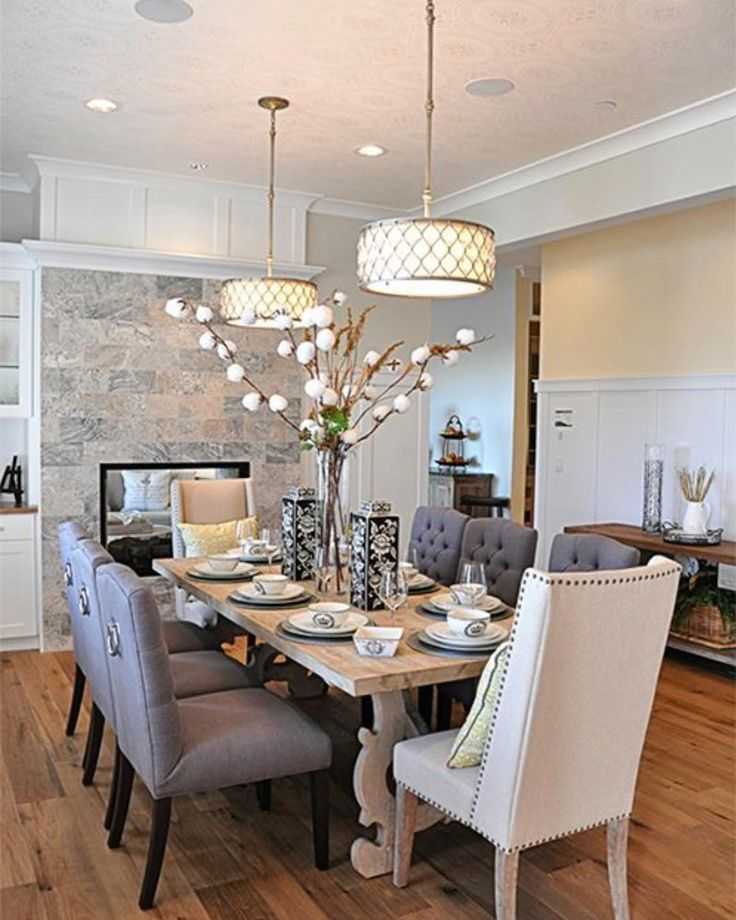
‘Bulkhead lighting means bringing the ceiling level down, usually around the perimeter of the room and at a variety of heights from 8 to 24 inches (20 to 60cm) – this will depend on the total height of the room. Usually bulkhead lighting will focus directly down onto the countertop level, so there is no worry of standing in one’s own shadow.’
Add accent lighting
(Image credit: Kitchens Of Holloways)
Don’t forget accent illumination when choosing kitchen lighting. It adds visual interest, contributes to the atmosphere of the space, and can highlight features of the room.
It can take many different forms. ‘Consider the “warm glow” areas where glazed cupboard lights can be left on to shine through glasses stacked on glass shelves to create an atmosphere while dining in the kitchen,’ suggests Alex Main, director of The Main Company .
Shane Hilton, designer at Harvey Jones, is a fan of using LEDs (light emitting diodes). ‘Colored LED lights are ideal for creating ambient and relaxing lighting effects,’ he says.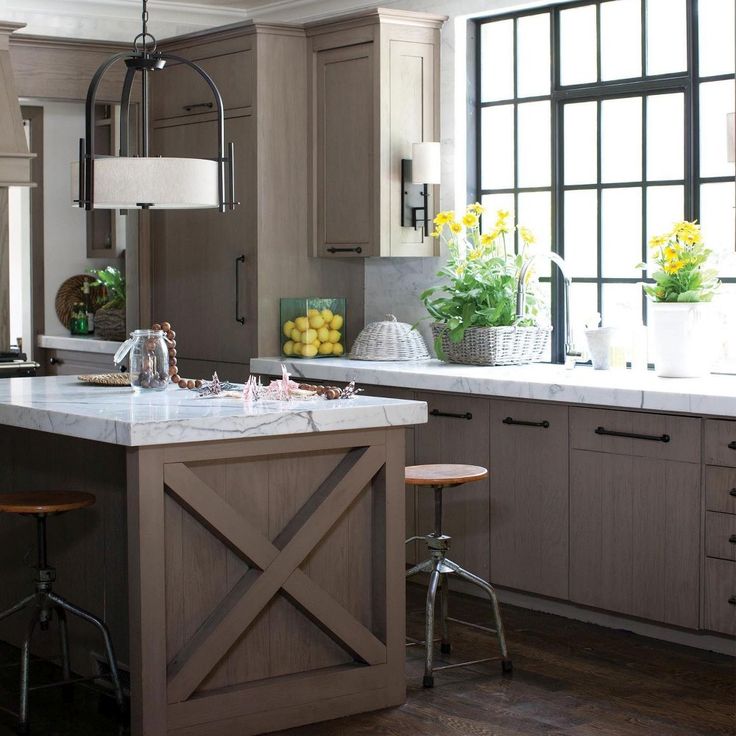 ‘Whether you’re after a cool, modern look with blue plinth lighting or a warm, comforting glow for an intimate kitchen/dining room, LEDs will do the job.
‘Whether you’re after a cool, modern look with blue plinth lighting or a warm, comforting glow for an intimate kitchen/dining room, LEDs will do the job.
‘They can give an almost infinite amount of color via the convenience of a remote control, with the added benefit of being long-life and maintenance-free, and having low running costs.’
We mentioned earlier that pendant lights can be dual function, providing task as well as accent lighting, and to use them in the latter role Helena Myers, director of The Myers Touch Kitchen Design Studio suggests: ‘Choose accent pendants over spaces like breakfast bars or other seating areas and drop them low to create more intimacy and atmosphere.’
Combining different lighting types
When choosing kitchen lighting you will be selecting the fittings that make up the task, ambient, and accent illumination for the space and it’s important that these can be operated individually. ‘Having the choice to switch lights independently from each other really makes an atmospheric space when the kitchen changes from a cooking to dining and relaxing space,’ says Alex Main.
Being able to dim some of the lights is also highly desirable. ‘Using dimmer switches on your main lights can also help create a glow in the evening – perfect for entertaining,’ says Melissa Klink.
What color light is best for the kitchen?
For a kitchen, opt for a cool white light. That means a Kelvin rating of 3,000 to 4,500. Warm, yellower light with a lower Kelvin rating is better for a living space rather than one where food preparation and cooking take place.
But bear in mind you should be able to change the mood. ‘The light you choose in the kitchen must be functional,’ says Karan Main. ‘However, it’s also important to create soft accent areas that contribute to a more ambient, social space for when the kitchen is not being used as a workplace.’
Do kitchen light fixtures need to match?
Kitchen light fixtures don’t have to match exactly, but the final effect should be a considered one. ‘If you are a person who enjoys an eclectic mix, make sure the tones match: for example, you could go from a light aged brass finish to a bronze finish, or a pewter to aged zinc finish,’ says Karan Main.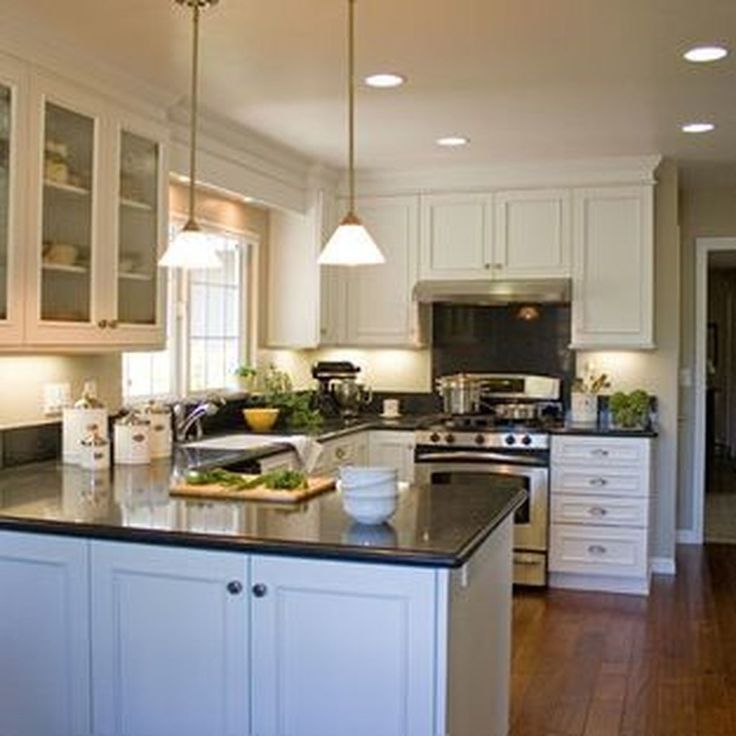
‘For those who prefer symmetry then it’s more preferable to retain a level of cohesion and use the same finish across the light fixtures, sockets and also cabinet hardware.’
How to Choose Kitchen Lighting
The heart of your home and your most lived-in space, your kitchen is where you make meals, prep after-school snacks, and everything in between. More than any other room in your home, it is important to make sure that your kitchen has multiple layers of intentional lighting. Here, we breakdown how to choose kitchen lighting to help you find the right lighting to illuminate this hardworking space.
Start with Overhead Lighting
No matter what kind of kitchen you have, large or small, good kitchen lighting starts with overhead lighting. This is the ambient lighting that reinforces the natural light that your kitchen already receives. This can be a pendant, flush, or semi-flush fixtures. Pendants are great for above an island, while several semi-flush mount lights may work best for galley-style kitchens.
Layer in Support Lighting
Brighten the spaces around your overhead lighting and highlight specific areas with support lighting—essential directional light that makes your space functional and illuminates the tasks you’ll be performing most.
Illuminate Your Island: Most islands act as a multipurpose space for prepping, cooking, and serving meals. Depending on the size of your island, installing several pendants or a small chandelier will provide ideal illumination for your entire space, choose pendants with a glass or light linen shade for a brighter source of ambient light. If your kitchen already has ceiling lights elsewhere, your island is where you want to add additional support lighting—directional light to illuminate the tasks you’ll be performing most. A pendant light with a metal shade will focus light downward on specific tasks like food prep or clean up.
Remember the rule of three: Three pendant lights will look balanced when evenly spaced to fill the span of a larger island, but don't be afraid to only use two pendants in smaller spaces.
Spotlight on Your Sink: Support lighting is also necessary above the kitchen sink—where you need to shine light on tasks like dishwashing or food prep. Elevate the area with a simple yet beautiful style like our Foster light with a clear glass shade.
Don't Forget the Dining Nook: An eat-in dining area is the perfect spot to add an elegant chandelier or an oversized pendant light that will bring style and personality to your space. From rectangular chandeliers above a banquette-style setup to modern pendants with colorful metal shades in small dining nooks, we have a range of styles and shades to suit every aesthetic.
Find the Right Finish
Consider the style you are going for when you are selecting the finish and consider the hardware you already have in your kitchen. Depending on the light fixture, the finish you choose can give the finished piece a different look. Decide whether you want to consolidate your finishes for a more polished look or mix your finishes for a slightly more eclectic vibe. If you choose to mix finishes, we advise choosing one finish for all your lighting and one for your hardware. Brass tones add warmth to a space, while Oil-Rubbed Bronze brings contrast and precision. Polished Chrome and Polished Nickel are classic choices if you are looking for a more streamlined, contemporary look.
If you choose to mix finishes, we advise choosing one finish for all your lighting and one for your hardware. Brass tones add warmth to a space, while Oil-Rubbed Bronze brings contrast and precision. Polished Chrome and Polished Nickel are classic choices if you are looking for a more streamlined, contemporary look.
Select a Shade
The shade style, size, and material you choose affects the light output. Many of our customizable fixtures come with many shade options—from vintage-inspired schoolhouse shades to sleek metal designs.
-
Clear glass: A clear glass shade will illuminate your entire space with bright ambient light. A glass shade pairs best with a filament bulb—we have 50+ styles to choose from.
-
Opal glass: Choose an opal glass shade for plenty of bright, 360-degree light with a more diffused glow than clear glass.
-
Metal: A metal shade focuses the light downward, making it an ideal option for targeted tasks or activities.
 If your kitchen has plenty of bright ambient light elsewhere, add pendants with metal shades above your island for more direct light above your cooktop or workspace.
If your kitchen has plenty of bright ambient light elsewhere, add pendants with metal shades above your island for more direct light above your cooktop or workspace. -
Linen: Fabric linen shades are best for above an eat-in dining space, due to the moisture in the air closer to the sink or cooktop.
Configure & Customize
All of our lighting is customizable and assembled to order at our Portland, Oregon factory—this means you can create a one-of-a-kind light that is configured-to-order for your space. Once you've picked the fixture style, finish, and shade, it's important to ensure you're ordering the right size and length.
Consider how big the fixture will feel in your space once it has the shade you've selected. Whether you're going for an oversized fixture or a streamlined trio of pendants, measuring your space accurately is key.
Here are a few quick guidelines that we recommend when measuring your space:
- The distance from the island countertop to the bottom of the fixture's shade should be 30-36 inches.
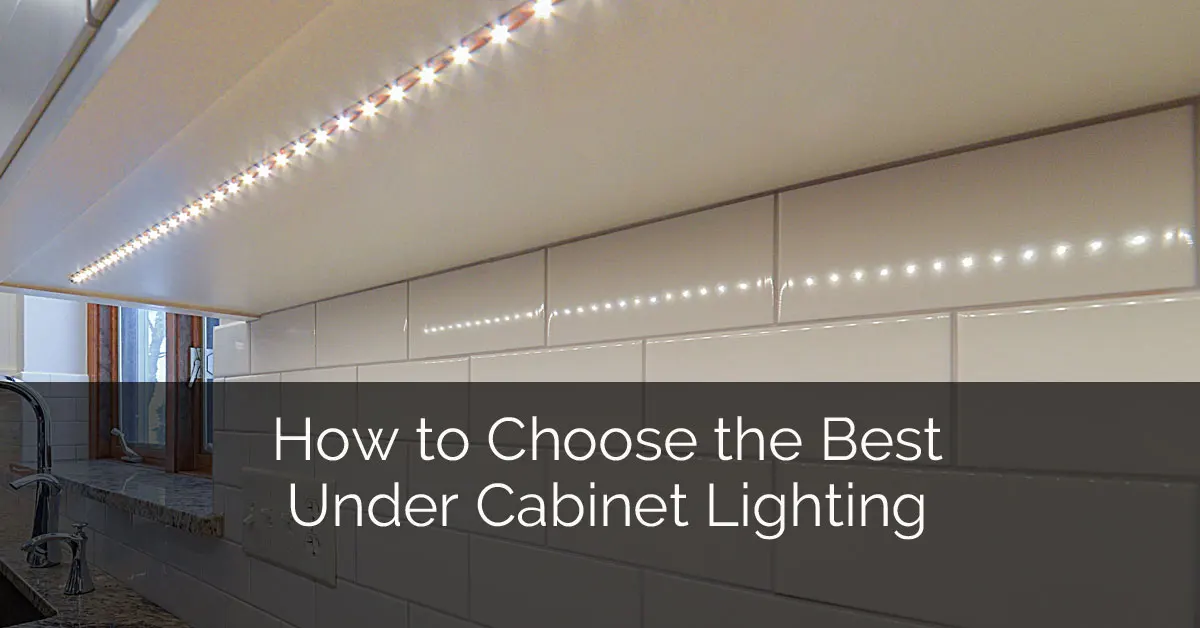
- 26-30 inches is the ideal distance between multiple pendants or lights.
- Allow 12 inches from the edge of the island to the light fixture.
Depending on the size of your space and kitchen island, some adjustments might be necessary. Test out your measurements by hanging a piece of paper or a balloon from a string taped to the ceiling—this will help you visualize how much space the light will take up and the right distance it should be from the floor or your workspace.
See our guide for How to Customize Your Light Fixture to see how you can create the right combination for your space, and shop our customizable lighting selection to get started.
Which lamp to choose for the kitchen
The kitchen has always been considered the central place in the house, where the whole family gathers together. A properly planned interior of this zone will help create comfort in a small apartment and in a country house. Modern design concepts are not limited to the selection of wall colors and furniture configuration, but take into account a lot of nuances, including kitchen lighting.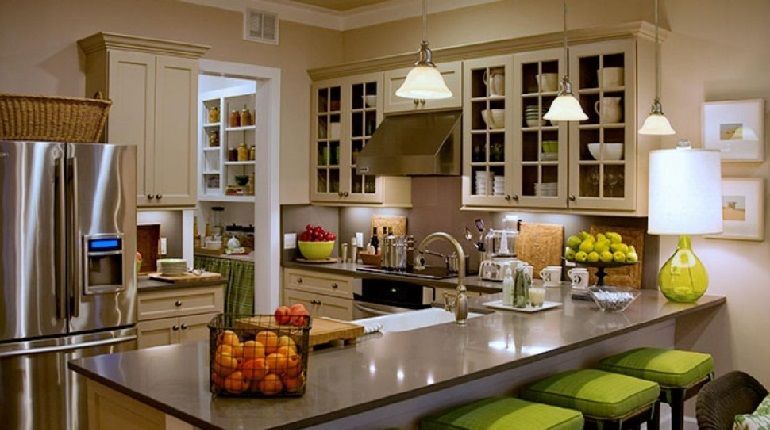 If properly selected, it will turn the room into a realm of peace and tranquility, as well as make daily household chores more enjoyable.
If properly selected, it will turn the room into a realm of peace and tranquility, as well as make daily household chores more enjoyable.
Kitchen lighting selection rules
How to choose a lamp for the kitchen? There are a number of general rules that you need to focus on in the first place, even before buying chandeliers or sconces.
- Divide the room into functional areas and work with each of them separately. So, the chandelier for the dining part of the room, of course, should be different from the lamp above the sink or above the work surface.
- Hide layout flaws and highlight original interior elements with lighting.
- Do not forget that artificial lighting should complement, but not replace, natural lighting. Adequate amount of daylight should enter through the window, which is why the kitchen is not a place for heavy curtains.
- The color of the walls and furniture is decisive for determining the number of lighting fixtures and their power.
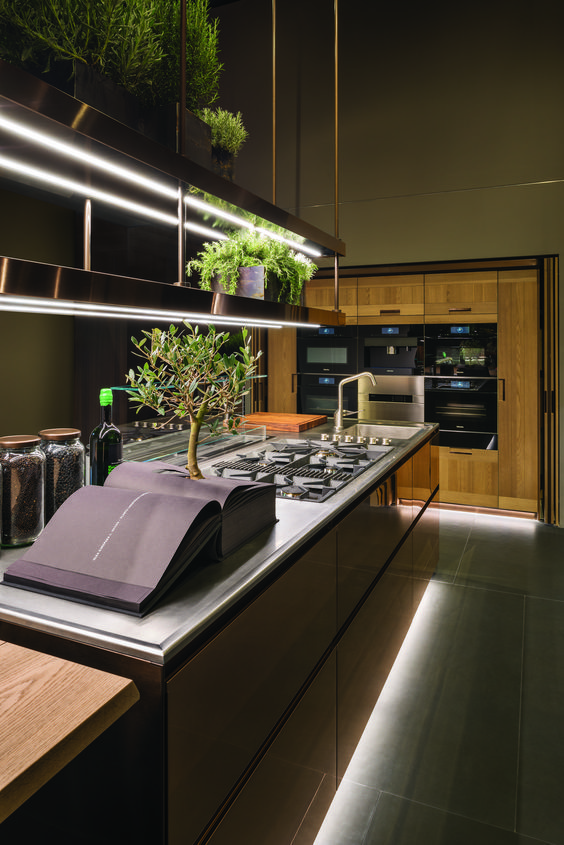 The darker the color range, the less light reflects and scatters the surface.
The darker the color range, the less light reflects and scatters the surface. - One of the most successful options is multi-level lighting with the ability to adjust the power of the fixtures. This will rationally distribute light fluxes depending on the time of day and emphasize the uniqueness of the interior.
When choosing a lamp for the kitchen, we must not forget that each element must fit into the overall concept of the interior.
Kitchen luminaires
Lighting devices that can be used in the kitchen can be divided into groups according to different parameters. If we use the functional purpose as a criterion, then we can distinguish:
- main or ceiling lighting;
- additional or local illumination of the dining and / or working area;
- decorative lighting.
Main lighting
Ceiling models are considered to be the main or central lighting. They not only provide the necessary level of illumination of the room, but also emphasize the design features of the kitchen design. When choosing specific models, important factors are the height of the ceiling and the geometry of the room.
When choosing specific models, important factors are the height of the ceiling and the geometry of the room.
A chandelier is a classic option for rooms with sufficient height. Otherwise, you will have to limit yourself to a ceiling or spotlights built-in. It is better to give preference to simple models. The complex design and unusual shape will draw attention to the low ceiling and visually make it even lower.
The central chandelier or ceiling can be used both as the only source of light in the kitchen, and in combination with other appliances - floor lamps, sconces. If the kitchen is elongated, you can use several separate lamps hanging from the ceiling in one row.
An equally popular option for organizing lighting is built-in point models. Depending on the configuration of the kitchen, they can be placed:
- along the center line of the ceiling in a rectangular room;
- in a circle in the center or around the perimeter (in a row or in a checkerboard pattern), if the kitchen geometry is close to a square;
- in the corners of the room to visually expand the space.

Very often, when installing spotlights, they are placed behind the cornice and directed to the ceiling. The light is diffused and soft, visually increasing the space and making the kitchen more comfortable.
If the kitchen is very small, as in Khrushchev, you can achieve optimal illumination in a specific area using several point light sources on swivel brackets. This will save a lot of space.
Additional lighting
Local light is always directed to a specific area: countertop, sink, bar counter, while it does not depend on the main lighting and does not violate its harmony. For this, models of lamps with a directional beam are used.
Work area lighting
Cooking in the kitchen should be comfortable. You can't do without good lighting of the working area. As a rule, this area includes a countertop for pre-preparation and cutting of products, a stove and a sink, where most manipulations take place. Properly selected options should, on the one hand, provide a sufficient level of illumination, on the other hand, not blind those sitting at the table. To illuminate the work area, you can use:
To illuminate the work area, you can use:
- overhead lights;
- directional light sources;
- LED strips.
Point models can be mounted in the elements of a multi-level ceiling. If hanging cabinets are located above the working area, then it would be logical to place lamps or LED strip directly on their bottom. You can choose more modern design solutions: hang lamps on rails or make a kitchen apron from light panels. When choosing fixtures for the work area, you need to take into account that this is the most polluted space in the kitchen. It is worth choosing waterproof models that are easy to clean if necessary.
Dining area lighting
The best place for a dining table is near the window. Natural light favorably affects the well-being of a person and his appetite. At night, additional lighting is indispensable. Ideally, it should be soft and close to daylight in its parameters.
The most common option is a pendant lamp with adjustable height and brightness. The lower the lampshade is located above the table, the more comfortable the space around is perceived. If the table stands along the wall, sconces or floor lamps with dense lampshades are used.
The lower the lampshade is located above the table, the more comfortable the space around is perceived. If the table stands along the wall, sconces or floor lamps with dense lampshades are used.
An alternative to such classic options is spotlights mounted in a multi-level ceiling with a warm light spectrum.
Decorative lighting
As the name implies, decorative lighting is designed to highlight unusual interior elements and design finds, as well as additionally zone the kitchen space. Usually, overhead lights or multi-colored LED strips are used for this purpose, located in wall niches or along the contours of the ceiling and floor.
Types of kitchen fixtures
Speaking about the design features of kitchen lamps, three types of models can be distinguished:
- suspended;
- invoices;
- recessed.
Pendant lights
This type includes lamps that are suspended from the ceiling.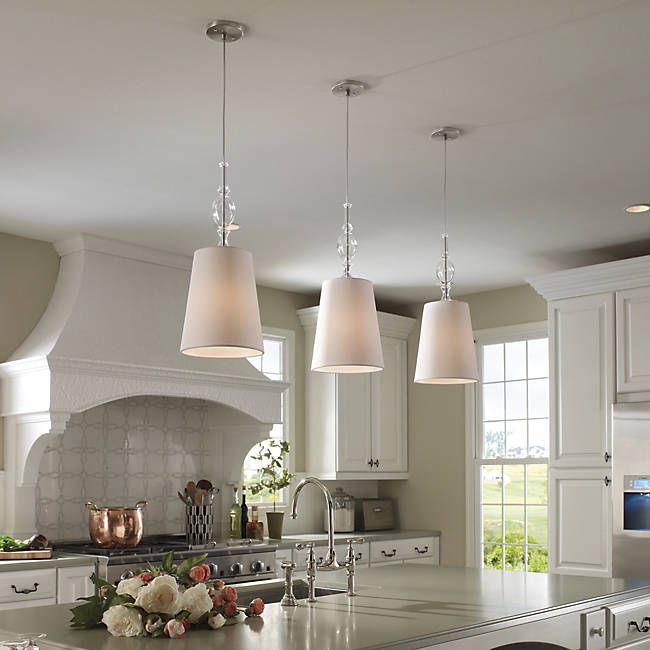 If the kitchen is equipped with stretch ceilings, the lamp must be attached to the main ceiling. The shape and material of the model does not matter. A classic example is a chandelier.
If the kitchen is equipped with stretch ceilings, the lamp must be attached to the main ceiling. The shape and material of the model does not matter. A classic example is a chandelier.
Suspended options are used mainly for organizing general or additional lighting. Depending on the interior design, these can be models with different angles of light dispersion.
Surface-mounted lights
Surface-mounted luminaires are in the shape of a washer. They are mounted directly on the ceiling, while remaining completely outside. It is allowed to use overhead lamps for stretch ceilings.
The angle of dispersion of rigidly fixed lamps, most often, is limited to 180 degrees. Some spotlights (spots) are available with a swivel mechanism. They have a dispersion angle of 30 to 60 degrees, but the design makes it easy to change their position and direct a narrow light flux in the right direction.
Overhead lamps are connected to the mains, run on batteries or batteries. Screws, a magnet or adhesive tape can be used as a fastening element in the structure. Such lamps can be installed even inside cabinets.
Screws, a magnet or adhesive tape can be used as a fastening element in the structure. Such lamps can be installed even inside cabinets.
Recessed luminaires
Recessed lights are completely hidden in the thickness of the ceiling. They are commonly used for spot lighting and decorative lighting, complete with stretch or suspended ceilings. These models are limited by the type of lamps used. In order not to melt the ceiling material, it is necessary to use only fluorescent or LED options.
Lamp types
The color spectrum of the lamp and its brightness depend not so much on the color of the shades, but on the type of lamps used. The following models are the most popular:
- incandescent lamps;
- halogen;
- fluorescent;
- LED.
Incandescent lamps
Lamps with conventional incandescent lamps are characterized by a warm light with a yellowish tint. It reflects well from the surfaces of objects and furniture, reduces contrast without tiring the eyes.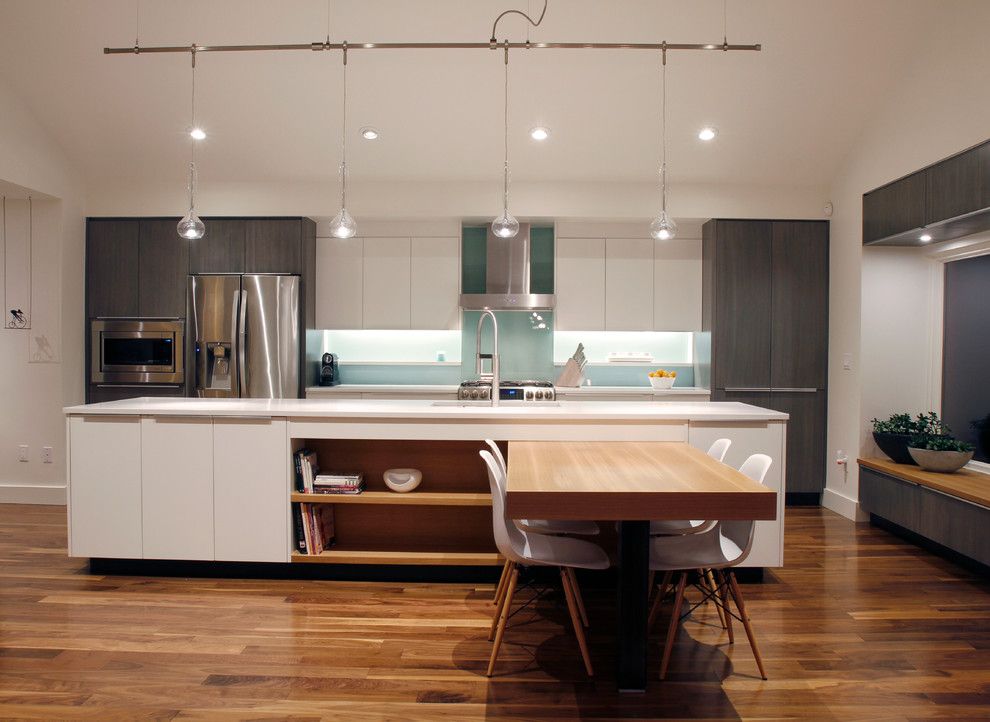
Incandescent lamps, on the one hand, have a low cost, but, on the other hand, due to the high level of energy consumption and short service life, they are losing their popularity.
Halogen lamps
With the increase in electricity prices, consumers have increasingly begun to pay attention to economical and energy-saving lighting devices. The duration of the lamp also plays a significant role. For these reasons, halogen lamps began to replace incandescent lamps.
Halogen lamps are usually used in recessed luminaires for suspended or stretch ceilings. In the list of their undeniable advantages are compact dimensions and long service life. The main disadvantage is the high price, but it is fully offset by the durability and cost-effectiveness of the product.
The variety of forms of halogen lamps on the market allows you to create original design elements using the main or additional lighting.
Fluorescent lamps
Fluorescent lamps are a gas-discharge light source that provides a neutral or cool spectrum.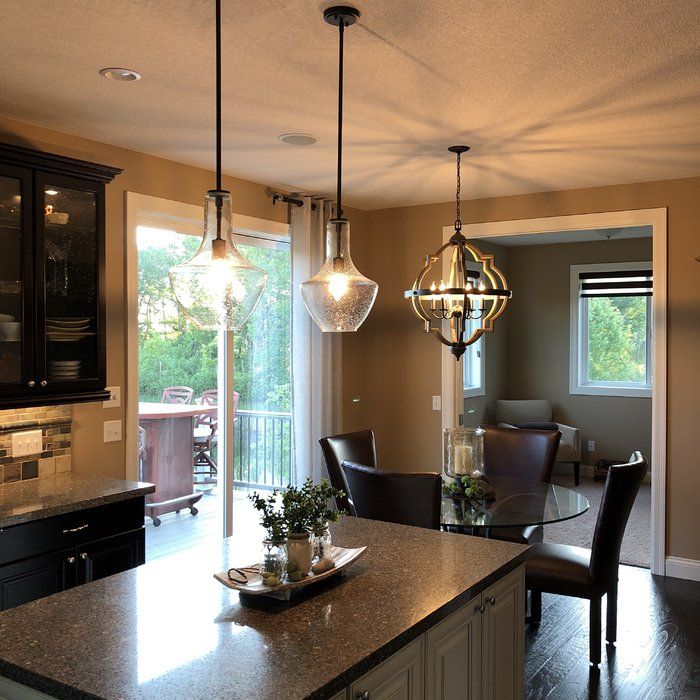 High light output, high efficiency and long service life ensured the high popularity of these models, however, all the advantages are crossed out by a significant drawback - the lamp starts to flicker with poor contact or voltage drop. The cold spectrum over time causes eye fatigue and headaches in people who are constantly in the room. In addition, it is important to remember that fluorescent models contain mercury, which, if the integrity of the bulb is broken, is a chemical hazard.
High light output, high efficiency and long service life ensured the high popularity of these models, however, all the advantages are crossed out by a significant drawback - the lamp starts to flicker with poor contact or voltage drop. The cold spectrum over time causes eye fatigue and headaches in people who are constantly in the room. In addition, it is important to remember that fluorescent models contain mercury, which, if the integrity of the bulb is broken, is a chemical hazard.
LED lights
LED lamps can be both independent lamps and act as a replaceable element for a lighting fixture. Among their advantages:
- different color temperatures and colors available;
- no heating under load;
- low power consumption;
- long service life: with proper installation and operation, they will work smoothly for ten years.
Thus, LED lamps are one of the best alternatives to the classic incandescent lamp. If an ordinary lamp has a power limit, it is always possible to replace the old version with an LED one with higher brightness.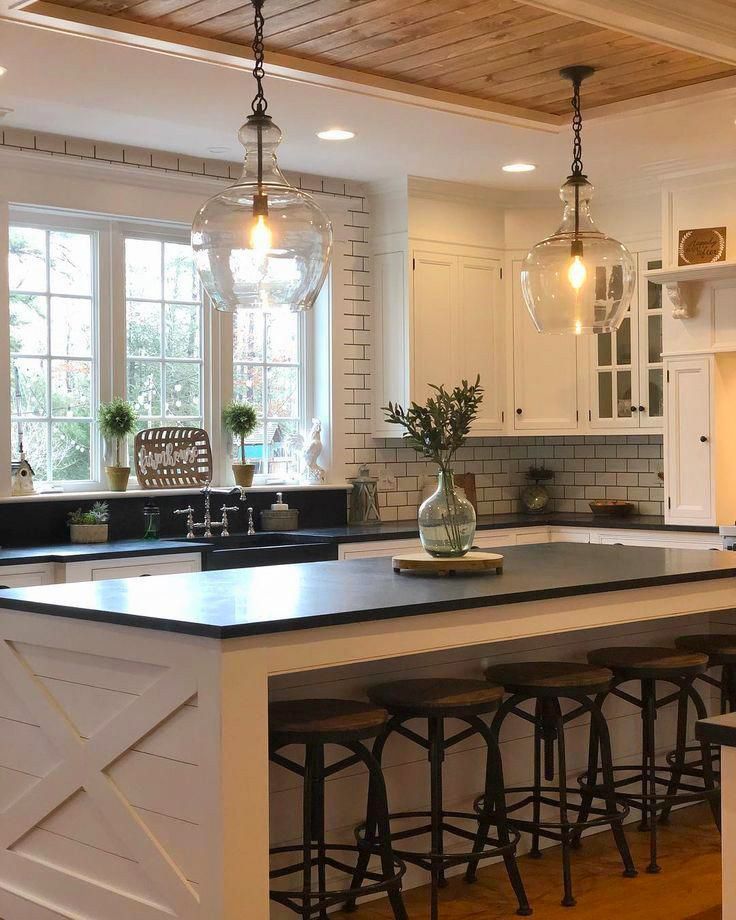 No one will notice the difference in the quality of lighting, despite the fact that efficiency will increase significantly.
No one will notice the difference in the quality of lighting, despite the fact that efficiency will increase significantly.
LED lamps are available in the form of long strips, which are convenient to use to illuminate separate areas of the kitchen or furniture. For original design solutions, models are used either with colored LEDs or with white LEDs and colored bulbs.
A little about the material of kitchen lamps
When choosing a lamp for the kitchen, it is important to pay attention to the material from which the device is made. It should be easy to wash off soot and grease stains. The most impractical are models with fabric or paper lampshades. It is important to remember a number of nuances.
- Lamps made of glass or crystal usually have many small details. However, such ceiling lamps, with the right choice of household chemicals, the ceiling lamps are easy to clean, and their cleaning does not take much time.
- Plastic is a practical and lightweight material, ideal for the kitchen.
 The only negative is that with prolonged exposure to the sun, plastic can fade and collapse.
The only negative is that with prolonged exposure to the sun, plastic can fade and collapse. - For metal products, ensure that the surface is treated with powder paint or mastic to prevent corrosion.
- Lamps made of wood suffer from excess moisture and temperature fluctuations. Such products must be coated with varnish or a specialized protective agent.
Lamps as an interior element
The lamp in the kitchen is not only a source of light, but also an element of the interior. It is important that the design matches the chosen style and does not look like an alien element against the background of color schemes, furniture design and decorative accents.
The classic interior is traditionally large kitchens with high ceilings. The style is associated with crystal chandeliers with metal suspension, which are installed mainly above the dining table. If the kitchen area allows, it is advisable to complement the chandelier with a wall lamp or candelabra in the same style.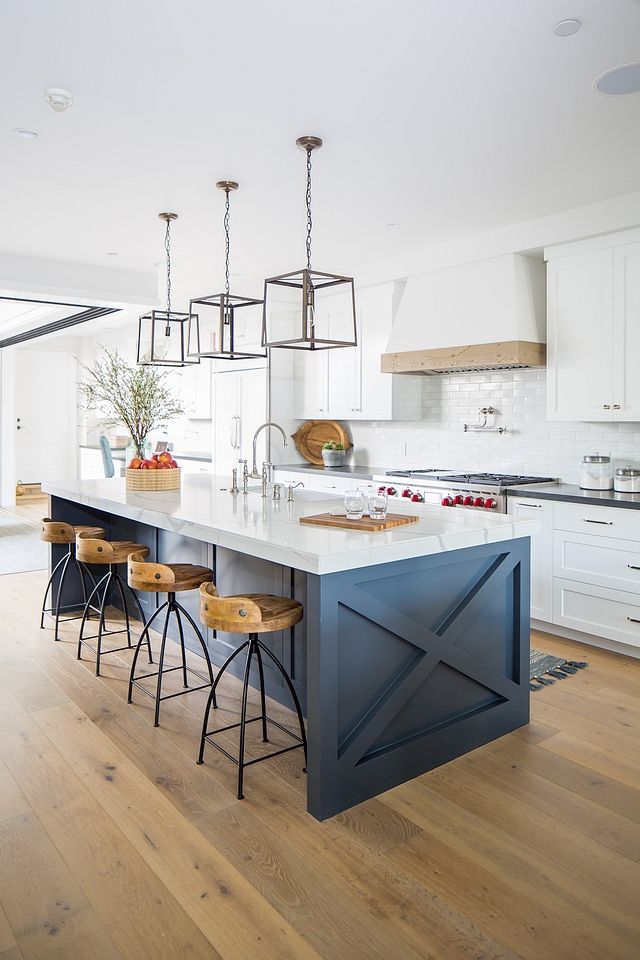
Provence style is called "French country". It is characterized by pastel colors, antique furniture, casual wall decoration, textiles with small floral patterns. Forged metal chandeliers with ceramic inserts and additional retro-style lamps with floral prints in neutral shades will organically fit into such a kitchen interior.
The loft style is recognizable in the photo and live by extremely high ceilings, undraped windows, and the absence of partitions. Communications are often not mounted in the thickness of the wall and are present as an element of decor. In the kitchen with a rough finish, modern equipment is installed with a predominance of metal (chrome or copper) parts. As artificial lighting, preference is given to a variety of ceiling and wall lamps. In such a kitchen, metal options are selected, reminiscent of street and industrial lights, characterized by rough execution.
Eco-style is based on free space with an abundance of light.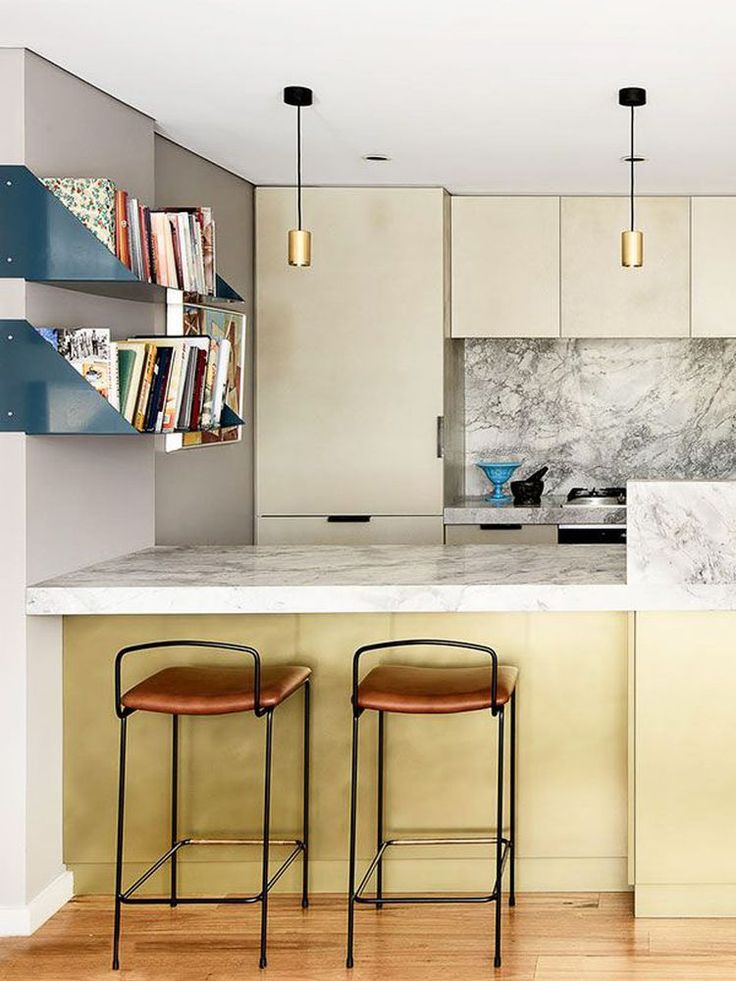 The decor uses only natural materials, and the colors are shades of sand, beige and light green. When lighting equipment, you need to choose floor lamps and ceiling lamps of an elongated cylindrical shape. Hidden illumination from halogen lamps will be very useful. For an eco-style kitchen, you can make lamps with your own hands from environmentally friendly materials - rattan, wood, or even dry snags.
The decor uses only natural materials, and the colors are shades of sand, beige and light green. When lighting equipment, you need to choose floor lamps and ceiling lamps of an elongated cylindrical shape. Hidden illumination from halogen lamps will be very useful. For an eco-style kitchen, you can make lamps with your own hands from environmentally friendly materials - rattan, wood, or even dry snags.
High-tech style combines the tough pragmatism of technological progress and the comfort of a home. A combination of an abundance of glass and metal, as well as a discreet, laconic decor, is mandatory. Discreet shades with clear geometric shapes fit perfectly into the high-tech kitchen. Avant-garde glass chandeliers are also suitable here. The main motive of such an interior is that there is never enough light!
How to arrange switches and sockets in the kitchen
The placement of sockets and switches seems like a trifle compared to solving more global issues: what furniture and appliances to buy and what lamps to choose for the kitchen. Meanwhile, if you do not pay attention to the problem, the work will not be as comfortable as it could be. There are a number of basic rules that must be taken into account even at the stage of breeding wiring.
Meanwhile, if you do not pay attention to the problem, the work will not be as comfortable as it could be. There are a number of basic rules that must be taken into account even at the stage of breeding wiring.
- The kitchen must have a sufficient number of outlets evenly distributed around the perimeter of the room. In addition to the main sockets for the stove, refrigerator, oven and dishwasher, it is necessary to provide separate connection points for any small appliances - microwaves, hoods, coffee makers.
- The location of sockets and switches must exclude their possible contact with water.
- The main lighting switch is usually located near the front door of the kitchen or immediately behind it.
- If separate switches are provided for the main, local and decorative light, their location must be separate, and not in one row.
Common mistakes when choosing lamps for the kitchen
- Positioning the lamp lower than 1.
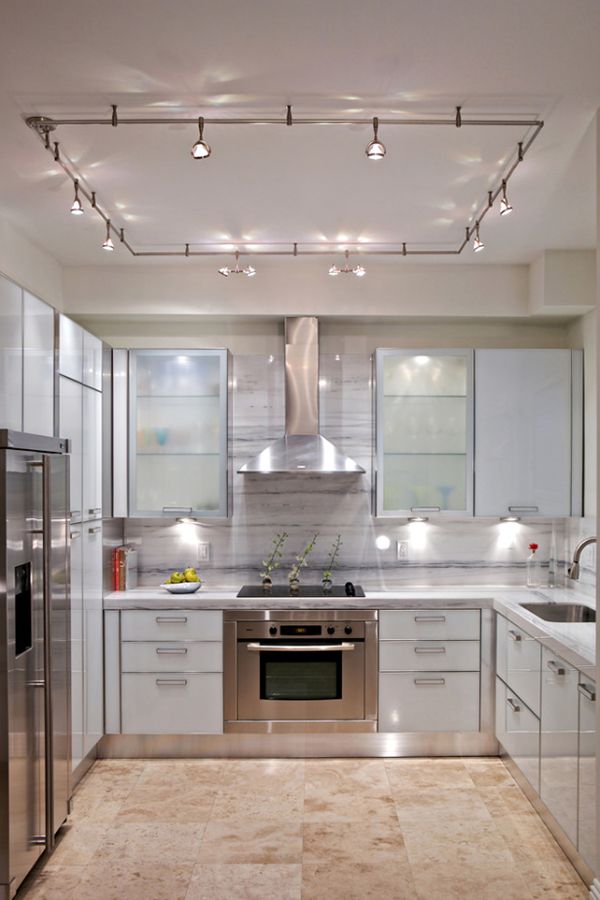 2 meters from the level of the countertop in the dining area. The luminous flux directed into the eyes will cause inconvenience to those sitting at the table. Usually, a chandelier is installed in a kitchen with a separate dining area on a telescopic rod or spring, which allows you to choose the desired height of the suspension.
2 meters from the level of the countertop in the dining area. The luminous flux directed into the eyes will cause inconvenience to those sitting at the table. Usually, a chandelier is installed in a kitchen with a separate dining area on a telescopic rod or spring, which allows you to choose the desired height of the suspension. - Savings on material quality. It is not profitable to change a failed cheap lamp both for financial reasons and for time costs.
- Installation of massive and multi-tiered chandeliers in rooms that are small in size or height. They visually compress the space, and sometimes interfere with normal movement.
- Choice of underpowered model for a large kitchen. The situation can be partially corrected with the help of additional light sources - spotlights, sconces, floor lamps and LED strips.
- Use of lighting fixtures with dark shades or low power fixtures in an interior with gloomy finishes. As a result, the illumination is not enough.
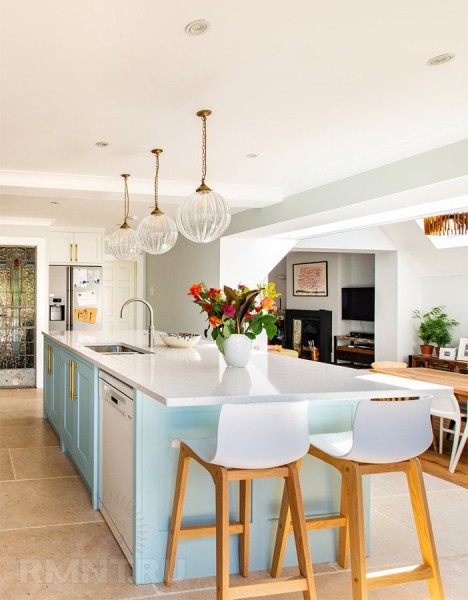
- A chaotic pile of pendant lights, especially in bright colors, in a small room. They visually reduce the ceiling and clutter up the space.
- Incorrect placement. If the chandelier is used above a dining table or bar counter, then it should be in the center.
- Use of the only light source on the ceiling. As a result, the working area is excessively darkened, which leads to inconvenience during household tasks.
Planning lighting for the kitchen only at first glance seems easy and quick. Meanwhile, it requires careful selection of each element, from the chandelier to the switches and sockets. If enough attention is paid to this problem, the kitchen will become a place where all family members will be truly comfortable.
Lighting in the kitchen: rules, photos, designer's advice :: Design :: RBC Real Estate
Properly distributed light will not only decorate the kitchen, but also make the cooking process as safe as possible.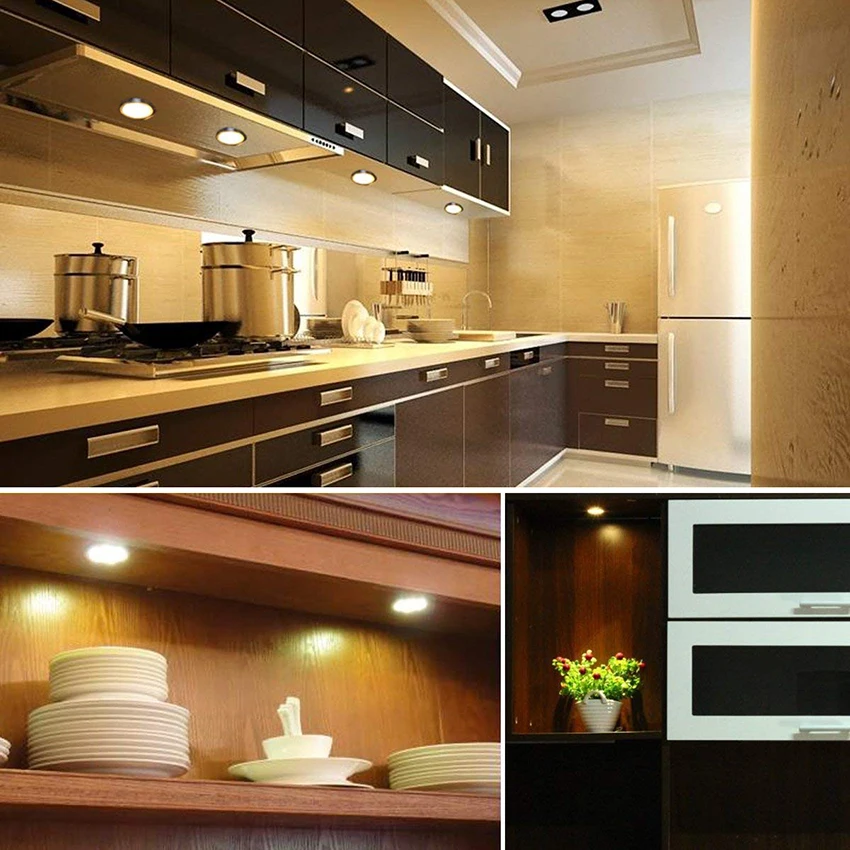 We figure out what nuances need to be taken into account when lighting the kitchen and why it is so important to separate the working and dining areas
We figure out what nuances need to be taken into account when lighting the kitchen and why it is so important to separate the working and dining areas
Photo: Aaron Huber/Unsplash
Someone was more lucky with the kitchen area, someone less. But in any kitchen it is important to properly organize the lighting. Even if the room is small or has errors in layout, with the help of lamps you can visually enlarge the space or focus attention on something, but, on the contrary, hide something.
- Basic rules
- Work area lighting
- Dining area lighting
- Decorative lighting
- Small kitchen lighting features
- About the choice of lamps
- Expert commentary
In the kitchen we prepare food and gather with family or friends. Therefore, it is very important to pay attention to the distribution of light. Shredding and frying vegetables, cooking soup or sauce require not only the presence of appropriate surfaces, but also good light - working in a gloomy space will not achieve the desired result, not to mention burns and cuts. And the dining area is better visually separated from the technical part of the kitchen.
And the dining area is better visually separated from the technical part of the kitchen.
adv.rbc.ru
Photo: Sidekix Media/Unsplash
There are four types of kitchen lighting - general lighting, work area lighting, dining area lighting and decorative lighting.
Basic rules
- It is important to separate work areas - for cooking and washing dishes - from the dining area. Each functional area of the kitchen is illuminated separately. Places where food is being prepared should receive more light.
- It is important to place the lamps so that shadows do not fall on work surfaces and the light does not hit the eyes or dazzle.
- Natural lighting must also be taken into account. If the kitchen itself is light, fewer lamps will be needed.
- To illuminate a small kitchen, it is better to choose fixtures in the same style.
- The color of the walls and kitchen units is of great importance - the lighter, the more light they reflect.
 Darker tones will require increased lighting.
Darker tones will require increased lighting. - It is not the floor that needs to be illuminated, but the work surfaces, so a single lamp in the center of the kitchen is not the best option. With a high probability, the cooking zone will remain insufficiently lit. It is better to dwell on multi-level lighting, which will allow you to harmoniously separate the zones.
- Cabinets are a necessary part of the kitchen interior, but they create additional shadows. This can easily be fixed by installing additional lamps nearby.
- And the last. The illumination rate for the kitchen, according to SNiP, is 150 lux per 1 sq. m. This is the minimum value, it is not recommended to make it darker, and lighter - at the discretion of the owner. You can measure the level of illumination with a special device - a luxmeter. There are alternative options, described in detail on the network, for example, using a camera and a sheet of white paper.
Work area lighting
For the most even and voluminous illumination of the work area, it is better to use several lamps.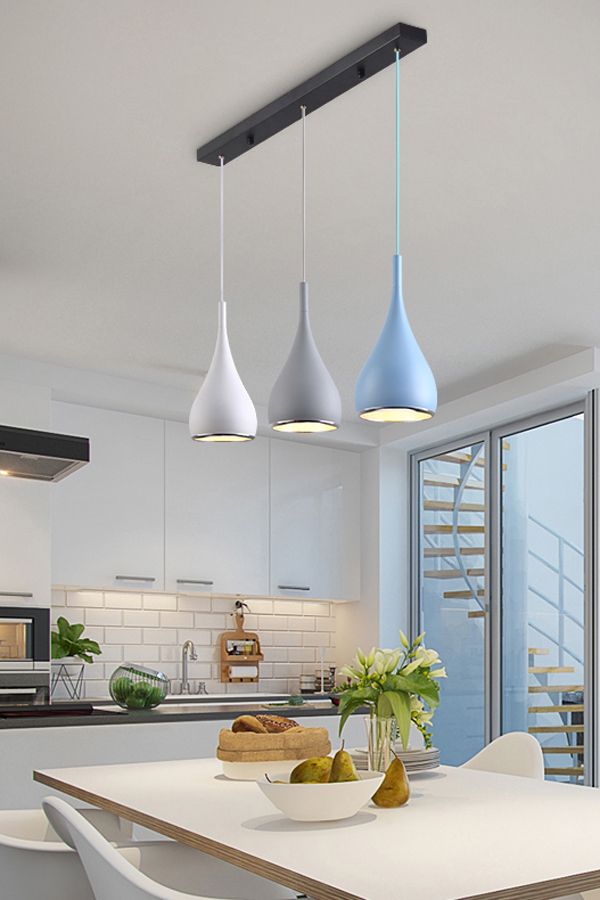 If wall cabinets are located above surfaces, fixtures can be placed under them so that the rays fall directly on the surface. You can use overhead spotlights to move them for a specific task.
If wall cabinets are located above surfaces, fixtures can be placed under them so that the rays fall directly on the surface. You can use overhead spotlights to move them for a specific task.
Photo: Max Vakhtbovych/Pexels
If the cabinets are too high, then the lighting can be arranged directly on the kitchen backsplash.
Dining area lighting
The dining area will look cozier with soft light. When designing a dining area, it is better to use natural light as much as possible. To do this, the table can be placed closer to the windows. If the layout does not allow this, sconces will come to the rescue.
Photo: Max Vakhtbovych/Pexels
If the dining table is placed in the center of the kitchen, ceiling chandeliers can be used. The halo of light from the lamp should cover the entire area. Multiple lamps can be used if necessary. An ideal option, especially for a small kitchen, is when their height can be adjusted.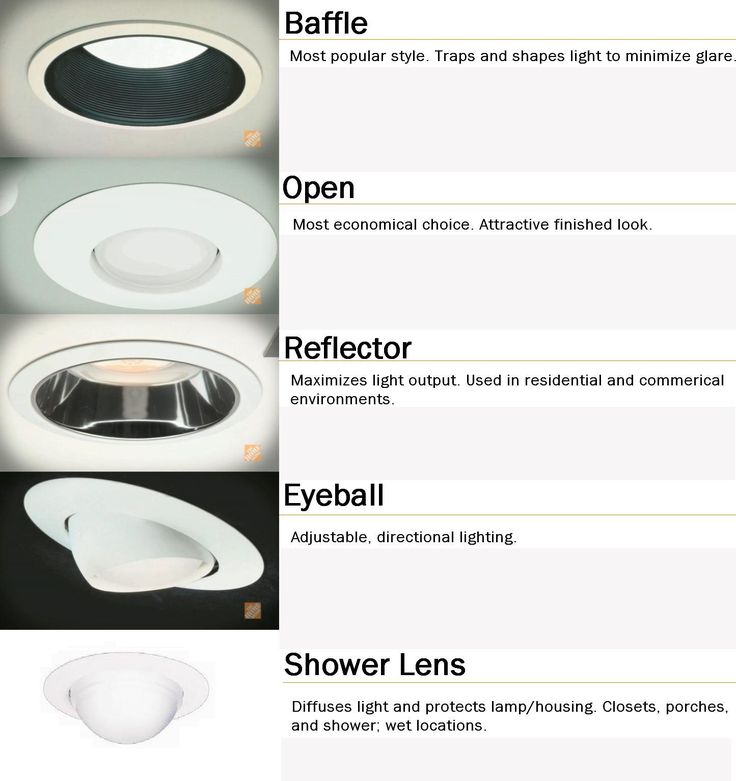
Decorative lighting
This type of lighting is mainly used to decorate the kitchen, but it can also be used to enhance the "bulb" functionality. Decorative lighting of cabinets not only looks spectacular, but also helps to quickly find the right item on the shelves. And the lighting of the kitchen set on the bottom visually increases the space. This solution is perfect for small kitchens. In addition, the effect of weightlessness of the cabinets is created - they seem to float freely in space.
Photo: Max Vakhtbovych/Pexels
LED strip under the ceiling can also create the effect of increasing the volume of the room, making it visually higher.
10 Ways to Visually Raise the Ceiling
Features of Lighting a Small Kitchen
It is easier to illuminate a small space, but even here one lamp is not enough. In small kitchens, general rules apply - the separation of zones, the use of several light sources.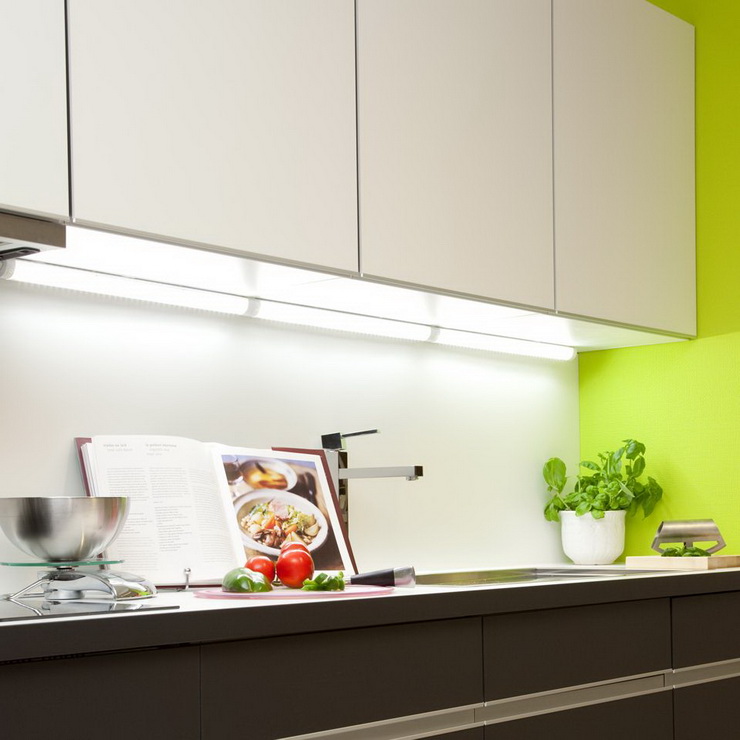 But there is a size adjustment.
But there is a size adjustment.
Photo: Shutterstock
The best option is a few spotlights or rotating spots, this will allow you to adjust the direction of the rays, illuminating a particular surface as needed. They can be placed in the corners of the kitchen - this method will visually expand the room.
A compact chandelier located in the center, as close as possible to the ceiling and with light directed upwards, will look harmonious. It will look especially advantageous with a glossy ceiling surface.
In a small kitchen, the general light can be at the same time lighting the dining area - a large number of lamps will only clutter up an already small space. But for the working and dining areas, it is worth considering your own, local sources of additional light.
Photo: Nick Karvounis/Unsplash
About the choice of lamps
The choice of lamps must be approached very carefully. Since the work process is going on in the kitchen, special requirements are put forward for lamps - moisture resistance, the ability to withstand high temperatures and exposure to steam.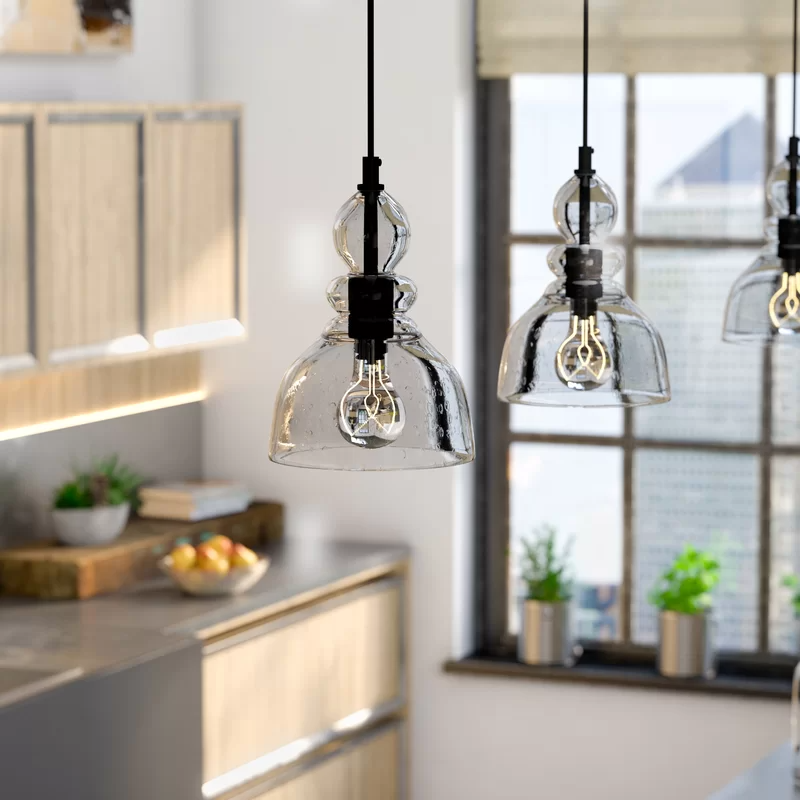 It is best to choose lamps that are as easy to use as possible. Do not forget that in cooking places, lamps will get dirty faster - it’s good if they can be quickly cleaned without much difficulty.
It is best to choose lamps that are as easy to use as possible. Do not forget that in cooking places, lamps will get dirty faster - it’s good if they can be quickly cleaned without much difficulty.
Expert comment
Ekaterina Lyubarskaya, partner of DVEKATI architectural studio:
— You should choose several lighting scenarios for the kitchen so that you can turn on certain groups of lights. Scenarios must match the lessons. The kitchen is not only a functional place for preparing food, but also, as a rule, the heart of the house, where the whole family gathers together. Holidays are celebrated there, guests are gathered there.
It's great if the kitchen area allows you to create a separate dining group with a large table. Then a light source can be placed above the table: even a fairly low lamp will become the center of the semantic space and will not interfere with anyone. It is better that such a lamp has a warm light, this will create an even more cozy atmosphere during family evenings.